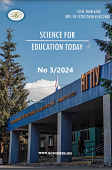Особенности развития мозга и способы коррекции при расстройствах аутистического спектра и синдроме дефицита внимания и гиперактивности: обзор современных исследований
Characteristic features of brain development and remedial methods for autism spectrum disorders and attention deficit hyperactivity disorder: Review of current research
Author(s): Sergei Anatolyevich Khaustov, Vyacheslav Albertovich DubyninSubject(s): Educational Psychology, Cognitive Psychology, Neuropsychology, Health and medicine and law, Inclusive Education / Inclusion
Published by: Новосибирский государственный педагогический университет
Keywords: Autism spectrum disorders; Attention deficit disorder; Hyperactivity disorder; Mental development disorders; Neurodivergent children; Neural structures; Comorbidity; Psychosocial correction;
Summary/Abstract: Introduction. Deep understanding of neurobiological processes in normal and abnormal children is crucially important for developing remedial procedures for mental development disorders and using inclusive learning methods. The purpose of this article is to summarize modern and most relevant information about the brain structure and functioning features in connection with disorders of neural structures, pathways and networks, as well as psychosocial and educational remedial methods for children with attention deficit hyperactivity disorder (ADHD) and autism spectrum disorders (ASD). Materials and Methods. The work is based on a comprehensive experimental research results analysis in the field of cognitive sciences and related areas affecting the issues of neurodivergent states. Research articles published between 2003 and 2024, mainly between 2021 and 2024, were used as materials. Results. Within the framework of this study, the authors identified key common and distinctive features of pathogenesis, epidemiology, and the neurobiological foundations of the ASD and ADHD development. Examples of disorders observed at the level of brain anatomical structures and functioning of individual neural networks are demonstrated. The spread of a symptomatic manifestations variety, concomitant disorders (comorbidity), the difficulty in differentiating the concepts of norm and pathology in a wide range of neurodivergent conditions are emphasized. Summarizing the data on various methods of therapy and treatment, the authors justified the key role of psychosocial adaptation within the framework of school education, which requires teachers’ understanding the peculiarities of mental development and techniques for interacting with neurodivergent children. Transmission of carefully selected information about the peculiarities of mental development to children seems to be relevant in order to help them understand their own problems and find solutions to them. These topics can be integrated into in the biology course given by appropriately prepared teachers. Conclusions. Rehabilitation and integration into society of children with ASD and ADHD is the main and practically the only way to solve the problem, requiring an understanding of the neurodevelopment peculiarities, conscious and tolerant attitude on the part of teachers, psychologists, parents and peers. The article is addressed to specialists in the field of psychology, special and inclusive education, pediatricians, educators, teachers, parents.
Journal: Science for Education Today
- Issue Year: 14/2024
- Issue No: 3
- Page Range: 154-181
- Page Count: 28
- Language: Russian

